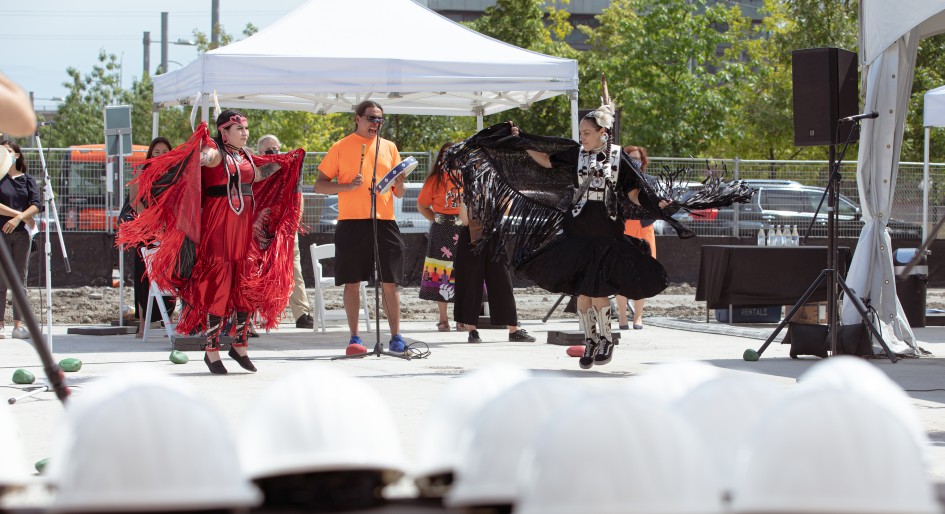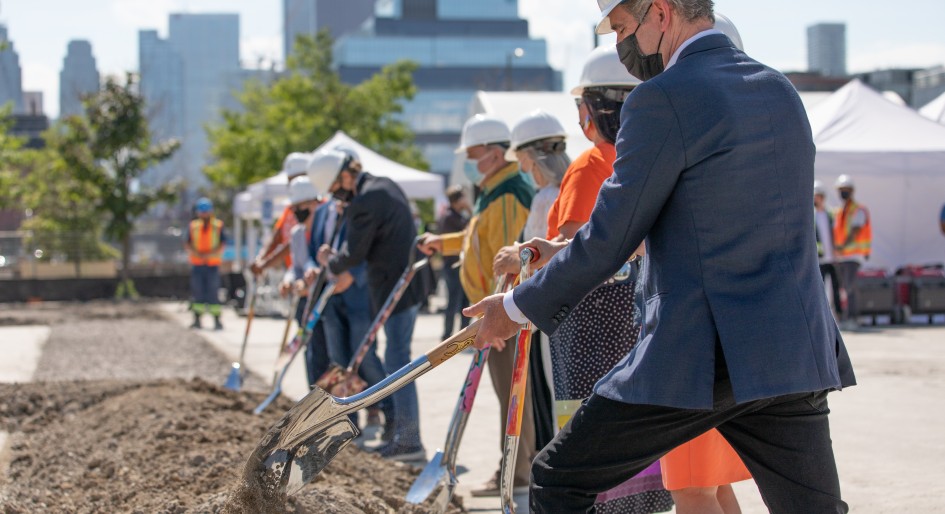Construction is officially underway on what will be Ontario’s first mixed-use, purpose-built Indigenous hub, set to rise on 2.4 acres at Front and Cherry Streets in the West Don Lands of Toronto.
Gathering for the groundbreaking ceremony on Monday were Indigenous-led organizations, government officials and developers who will all be working on the multi-million dollar, multi-funded project, which has been taking shape ever since the Pan Am/Parapan Am Athletes’ Village evolved from its brief 2015 Games-related uses.
Ontario transferred this particular lot to Anishnawbe Health Toronto (AHT), which partnered with Dream, Dream Impact Trust, Kilmer Group and Tricon Residential to co-develop the site for residential and retail uses.
A goal of the Canary District project is to increase vital services for the Indigenous community in the GTA. Guests were on hand to discuss why this is more important than ever.
At the heart, is a new home for AHT,—currently the only facility of its kind in the city—which combines traditional healing practices and western medicine for its Indigenous clients. At four-storeys and 45,000-square feet, it will be open in 2022 as Anishnawbe Health Toronto Community Health Centre. The rest of the hub is slated for 2024.
“The site will be a gathering place for the Indigenous people from across Turtle Island and a home to support the reclamation of culture and identity,” AHT Executive Director Joe Hester said during the ceremony.
Working in tandem with AHT, Miziwe Biik Training Institute will double its physical space to create more training and employment opportunities for urban Indigenous Peoples, with a hands-on carpentry workshop, tutoring classrooms, a business incubator and other multi-purpose training spaces.
In a typical year, Miziwe Biik serves about 1,200 clients, of which 40 per cent return to school and more than 50 per cent gain employment. Nancy Martin, executive director of Miziwe Biik, said more needs to be done to remove a disproportionate training and job gap.
“There are an estimated 70,000 Indigenous Peoples living in the Greater Toronto Area, and the unemployment rate of off-reserve Indigenous Peoples is 11 per cent—double that of non-Indigenous Canadians,” she said on Monday.
In mixed-use style, the hub will include a childcare centre for 49 children, a new Indigenous EarlyON Child and Family Centre located in Miziwe Biik, the restoration of a 1850s heritage building, Canary House mixed-use condo, and purpose-built rentals.
Beyond its industrial past, the site is poised to bring green space to a once obsolete block, and thoughtful planning, too, with numerous community engagements. As design consultant on the entire project Indigenous-led Two Row Architect developed eight Indigenous design guidelines to make sure all aspects of the hub honour Indigenous knowledge, history and values. BDP Quadrangle and Stantec also designed the masterplan.

The milestone was celebrated with a socially-distanced event and featured First Nations drummers Young Creek and shawl dancers, reflecting the star blanket shawl-inspired design of the new home for Anishnawbe Health Toronto. Photo by Red Works Photography.
“This milestone is a major achievement showing how open dialogue and collaboration can help achieve common goals, said Ken Tanenbaum, vice-chair of Kilmer Group. “We look forward to seeing the Indigenous Hub become a vibrant, welcoming place for all.”




